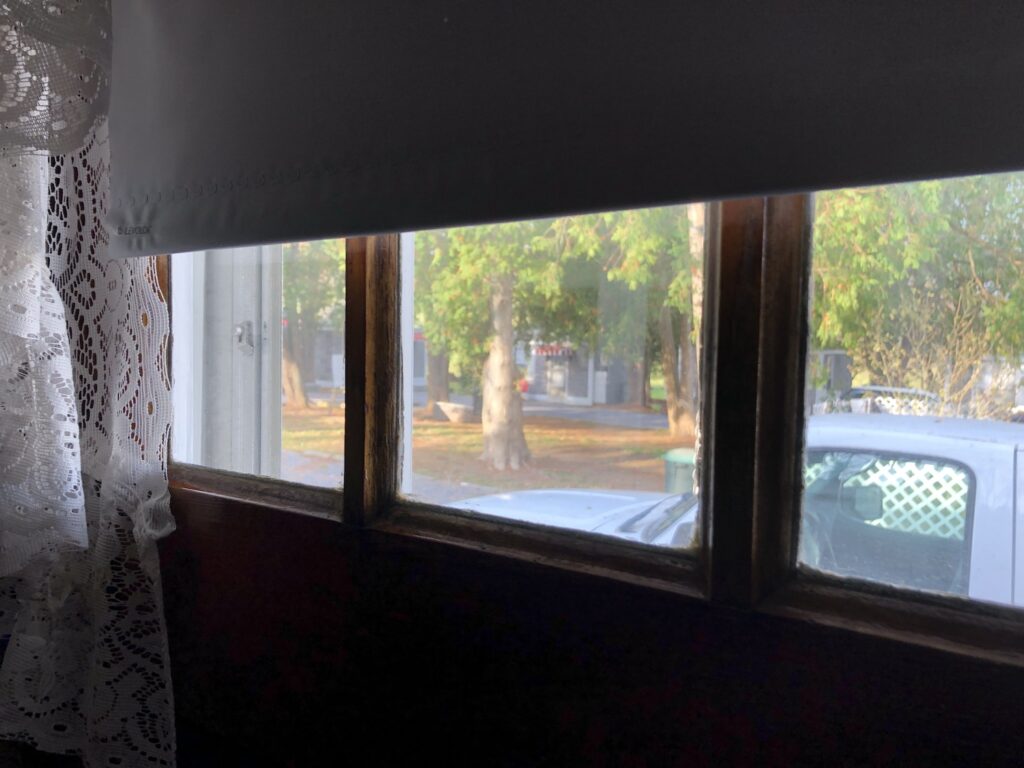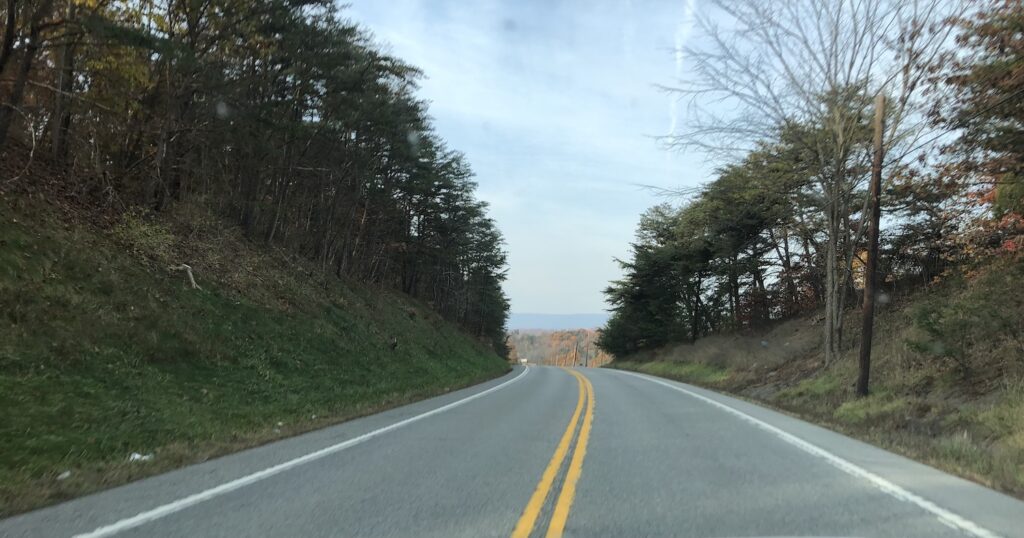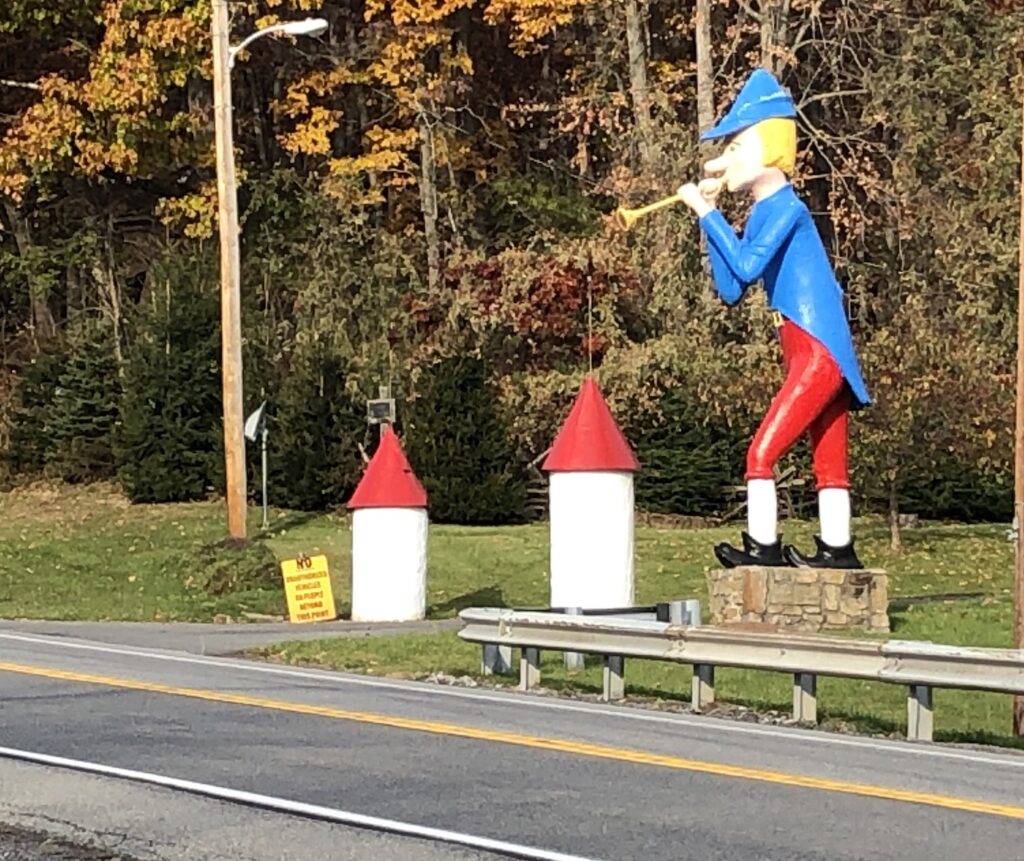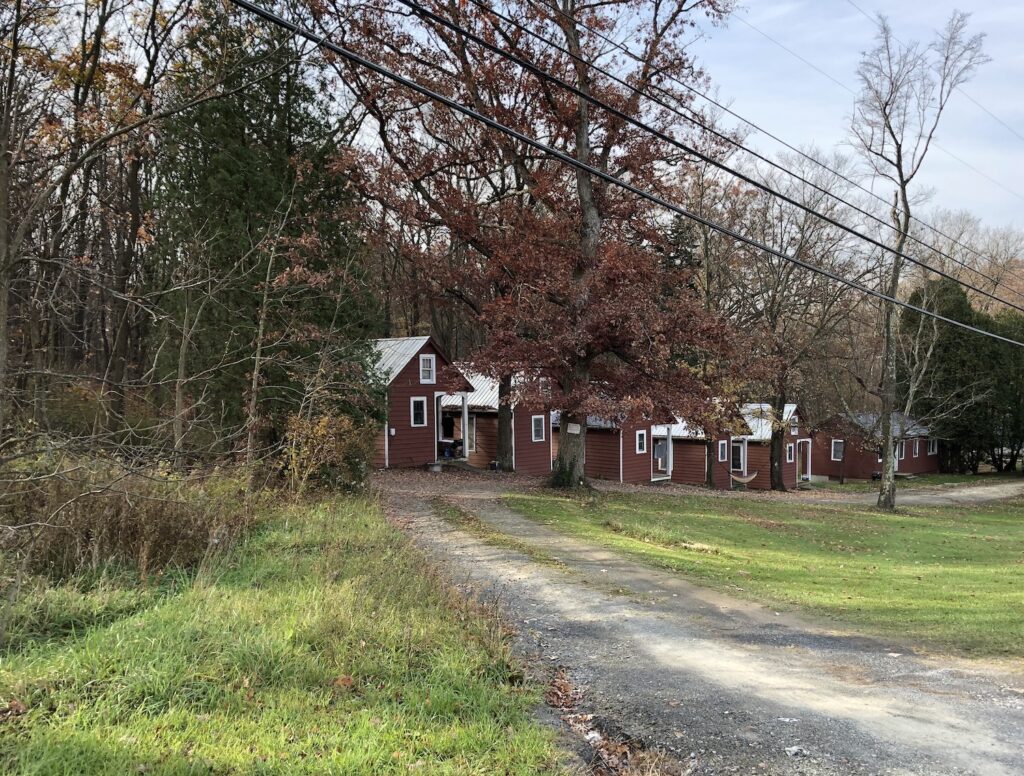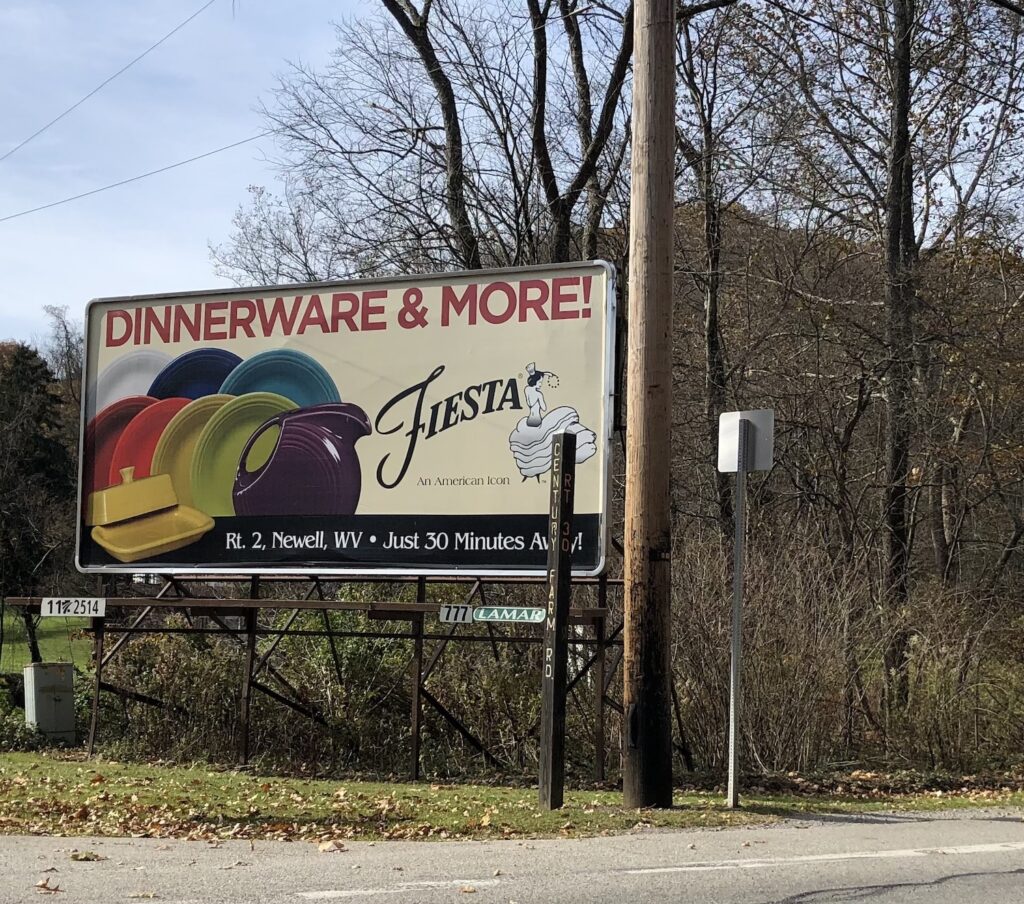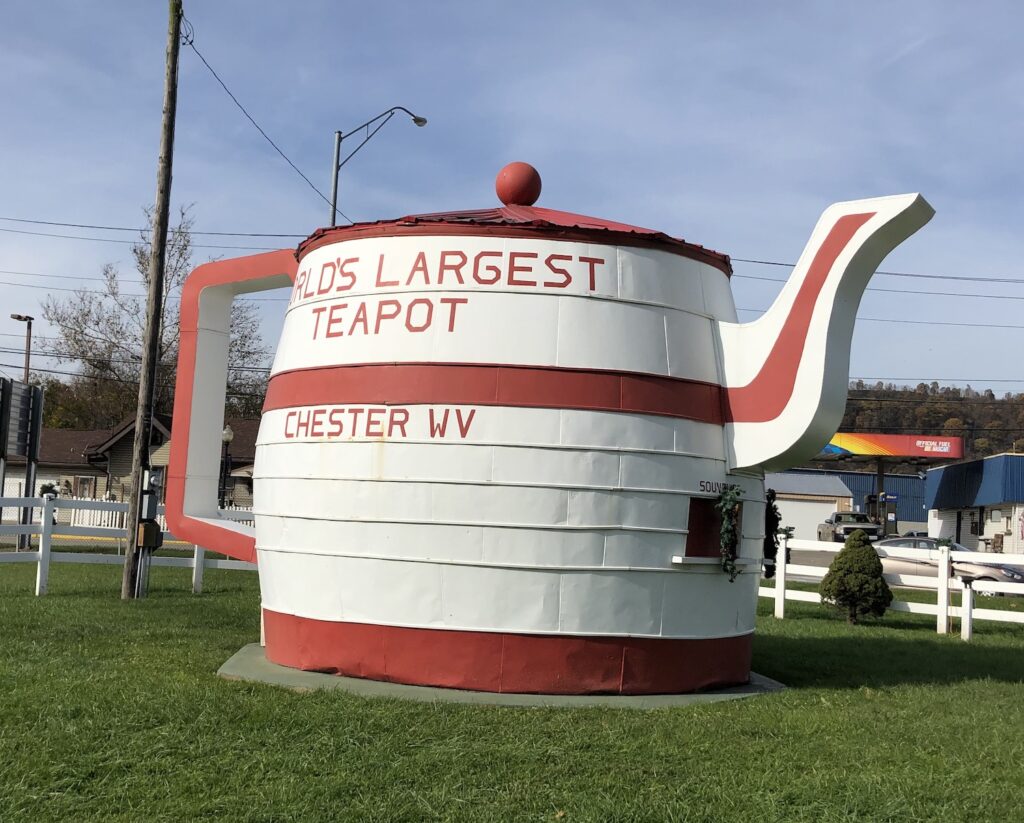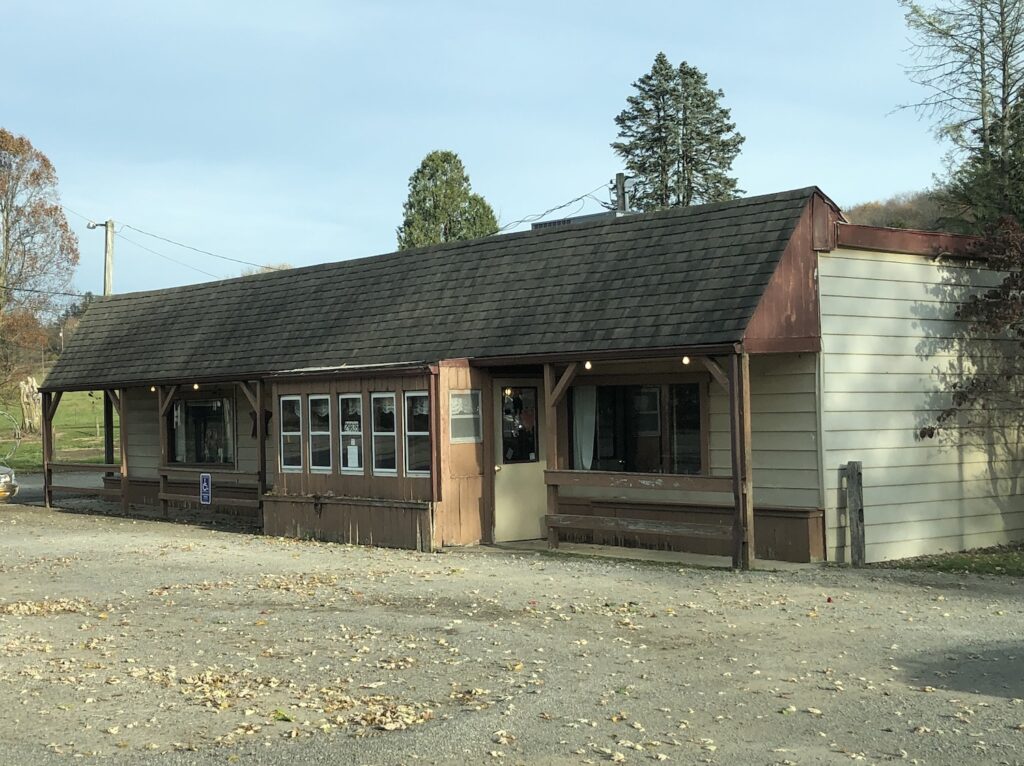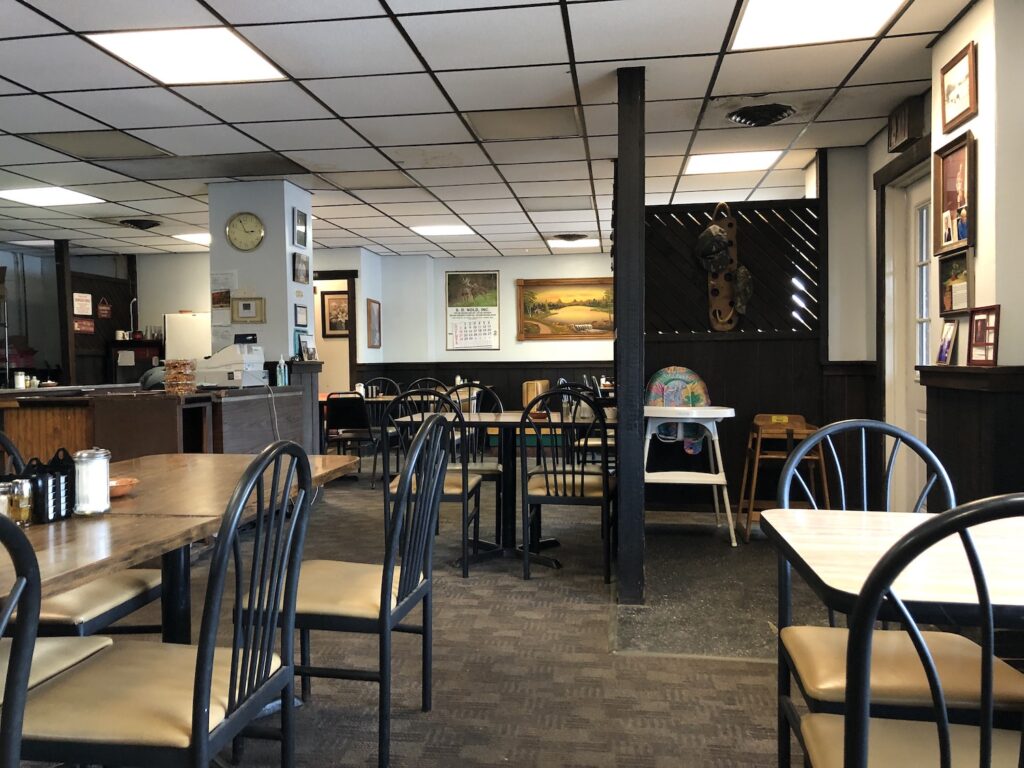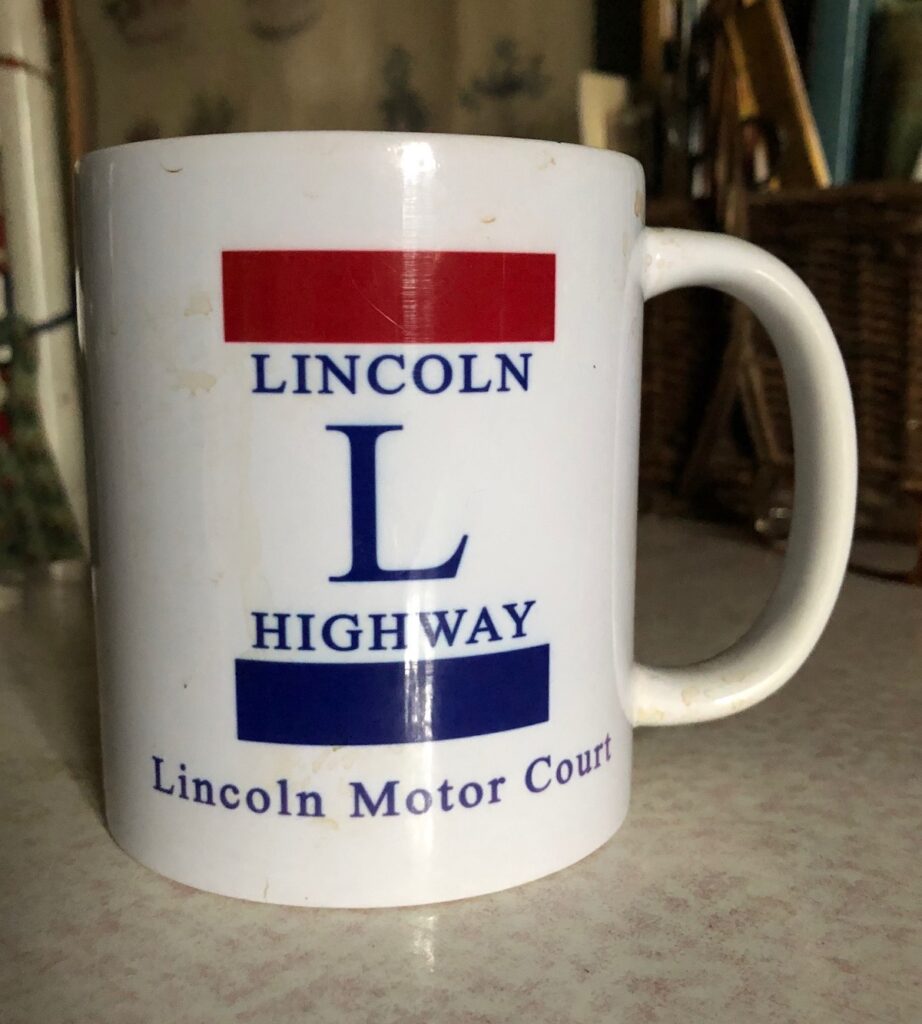My last day on the road, like the three previous, dawned beautifully sunny and pleasant.
I was ready to take on the Alleghenies! This time in daylight! I headed west back to Schellsburg, where I passed the grocery that had saved me from hunger my first night out.
Little had I realized that I passed that night Little Boy Blue (or the Pied Piper, depending on what source you believe), which marked the entrance to the long-defunct Storyland, a 1950s roadside attraction that closed in the 1980s. Evidently many of its features are still there, hidden back in the woods, but it is private property. And, to reduce my temptation further, I was still nearly 500 miles from home.
But I did try to get on some of the original alignments where possible. This one, west of Schellsburg, was lovely in the morning sun.
And it passed an 1806 log church that is listed in the National Register and evidently still used, at least occasionally.
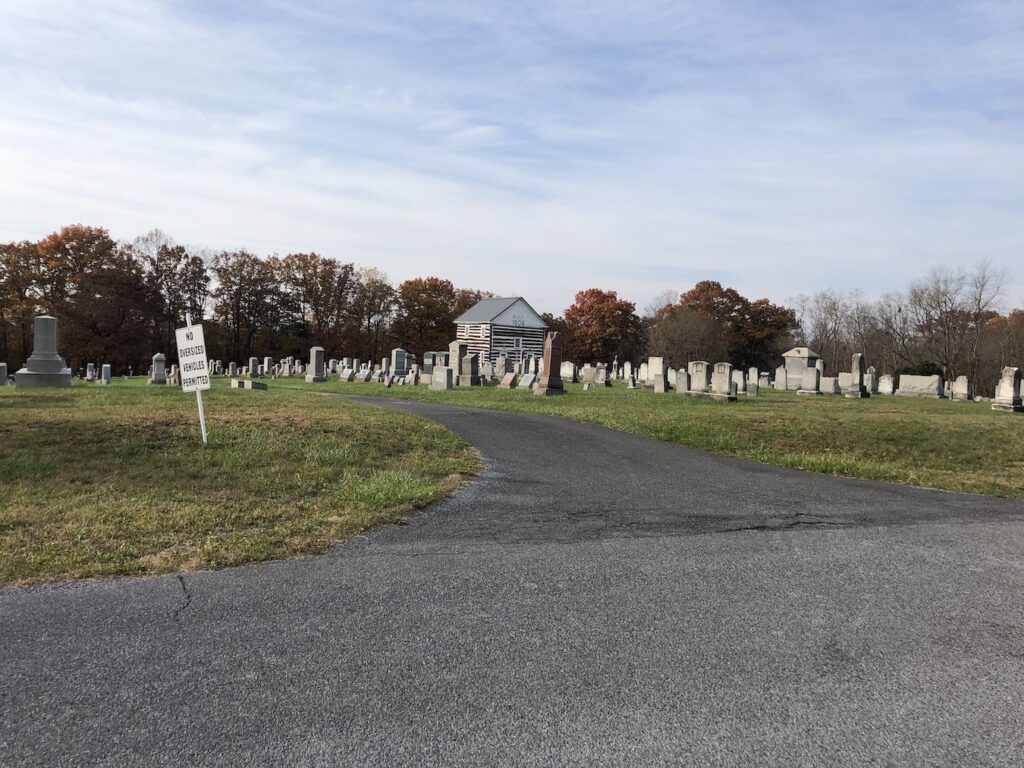
This fairly short stretch of the road was especially scenic with a quite a lot of roadside attractions, past and still present.

Apparently I somehow passed the overlook where the long gone and much mourned Grand View Ship Hotel once stood. It is not commemoratively marked, but I recalled a sign indicating an overlook at something over 2900 feet. That must have been it. I was too busy careening up and the mountains to go back, flying past runaway truck ramps and signs warning them to use lower gears. That caution applies equally to baby pickup trucks, too. The sights I missed in the dark a few days before now were before me, and I had fleeting thoughts of how fortunate it was that I hadn’t gone tumbling down a mountainside in certain spots. In the dark I had certainly adhered to the posted 35mph limit, and I didn’t run too far above it in daylight. I caught some of roadside artifacts the books mention: a bison farm, abandoned tourist cabins, derelict buildings that once might have been inns–a glorious morning! The stretch between Jennerstown and Laughlintown was particularly wild and woolly–and spectacular.
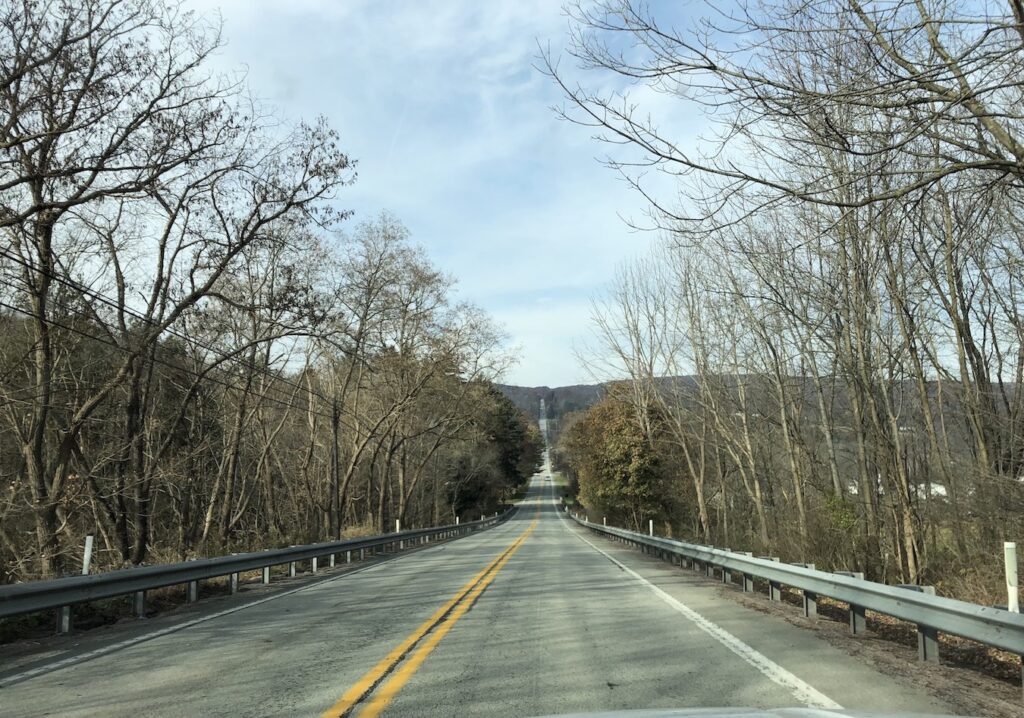
Then I hit the sprawl stretch northeast of Pittsburgh, which is singularly unlovely and boring with chain names one can see anywhere in the country. I did spot a nice stretch of the original road about to the left and I followed it for a bit, but as with so many of these, it was insufficiently marked and I was not certain where I would end up. I made my way back, which afforded me the opportunity to cross the later Lincoln Highway route across the massive George Westinghouse bridge, constructed in 1932 (mentioned in chapter one of this blog series).
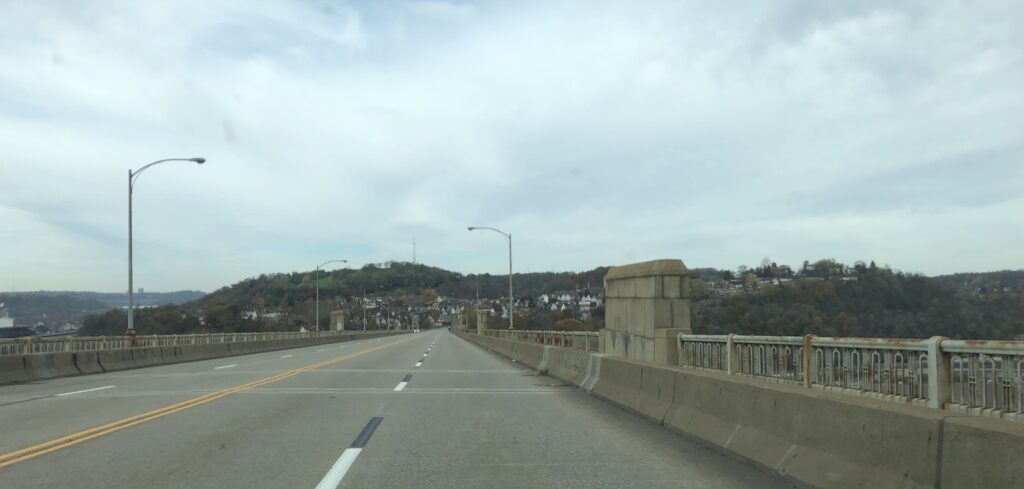
I would have thought I was crossing one of Pittsburgh’s three rivers, but no, it was Turtle Creek, far down in a broad valley where the huge Westinghouse factory complex, begun in the 1890s, once sprawled. Some of the buildings survive and at least some of them are used for manufacturing.
I swung around Pittsburgh, realizing from my first day’s experience that I had not the time to try to follow the old route through nor to pick up the original iteration that skips West Virginia entirely.

But I picked up the second iteration on the other side of Pittsburgh via the Steubenville Pike, and this time enjoyed the few bits of roadside artifacts to be seen without following a poky box truck. An occasional flying leaf skittered across the road or smacked into my windshield, adding to the joyful feel of it.
Seeing the sign for the Homer Laughlin factory, I decided to diverge south from route just a little to see it. (And besides, the original Ohio River crossing had been farther south, so I wanted at least to see where it was.) The town of Newell, where Homer Laughlin is located, once had many pottery factories, but for the most part only vacant lots and crumbling ruins remain, not dissimilar from those of the auto-related industries in Indiana. I made my way back north to Chester where the bridge is and stopped at the iconic World’s Largest Teapot, moved from its original location farther south to where it can be seen from the approach to the bridge on US30. Starting life as a root beer stand, in 1938 the barrel-shaped structure was moved to a spot on the recently reconfigured Lincoln Highway and remodeled into a giant teapot in homage to the local pottery industries. The owner had a china shop behind it and sold refreshments and souvenirs from the Teapot. Eventually it languished and suffered multiple owners, but the town of Chester eventually received it, and local groups moved the Teapot to its current location and refurbished it. (It is, by the way, smaller than the giant coffee pot about 150 miles east on the Lincoln Highway.)
The area where the bridge approach is now had been a popular amusement park called Rock Springs, built in 1897. Like most of these from the trolley park era, it was fading by the 1960s, conveniently so, for the builders of the new bridge wanted the land. Still, its loss is much mourned even today, and souvenirs from Rock Springs are highly prized. A commemorative marker notes the site. Had I my druthers, I would probably have spent a day just around here on both sides of the river, including a revisit to the ceramics museum.
I crossed the bridge into East Liverpool and tried to follow some of the old route through there, stumbling onto the largest Carnegie Library I had ever seen. (I come from Indiana, which boasts the greatest number of such libraries built in the country, some 164. I have seen nearly all the extant ones.)

I somehow missed the old route out of town into rural Ohio, but I did stop in the beautiful Riverview Cemetery that overlooks the Ohio Valley and where Henry Ostermann, a name known to Lincoln Highway aficionados, is buried. He was the Lincoln Highway Association’s Field Secretary and among its most effective promoters. Ironically, Ostermann was killed in Iowa while merrily speeding on his road.
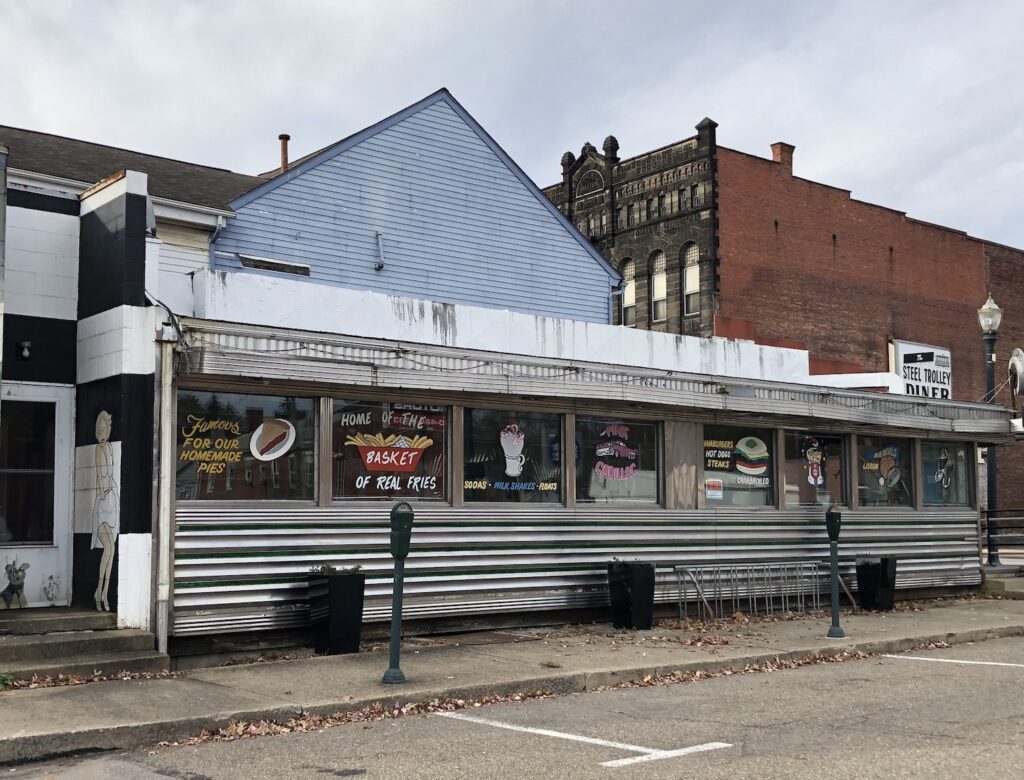
Eventually finding the Lincoln Highway again, I returned to Lisbon and another look at the Steel Trolley Diner. Famished by this time, I still hoped for a diner–one that was open, that is–or a small town cafe. West out of Hanoverton I spotted a tired little cafe called the Avalon Family Restaurant.
It felt a bit like an “Easy Rider” moment when I walked in–there were only four customers, clearly regulars, sitting at a table, chatting with the owner and the waitress and eying me curiously, but the food was good.
I headed into the clouding sun and Minerva, where a roadside cow advertises a regional dairy of the same name, whose storage tanks are painted in black and white like Holsteins.
By the time I approached Canton it was rush hour and I elected to take the US30 bypass, since I had gone through it on the way east. I skipped over Massillon, but slipped through Dalton.
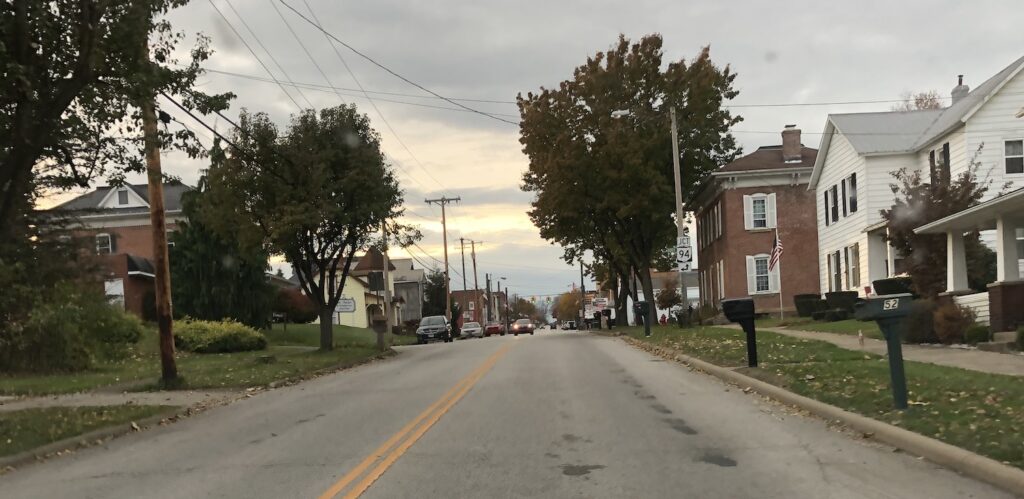
I skipped my beloved Wooster too, but hopped on the old road into Hayesville and Mifflin. The sky was darkening very fast and some sprinkles hit my windshield.
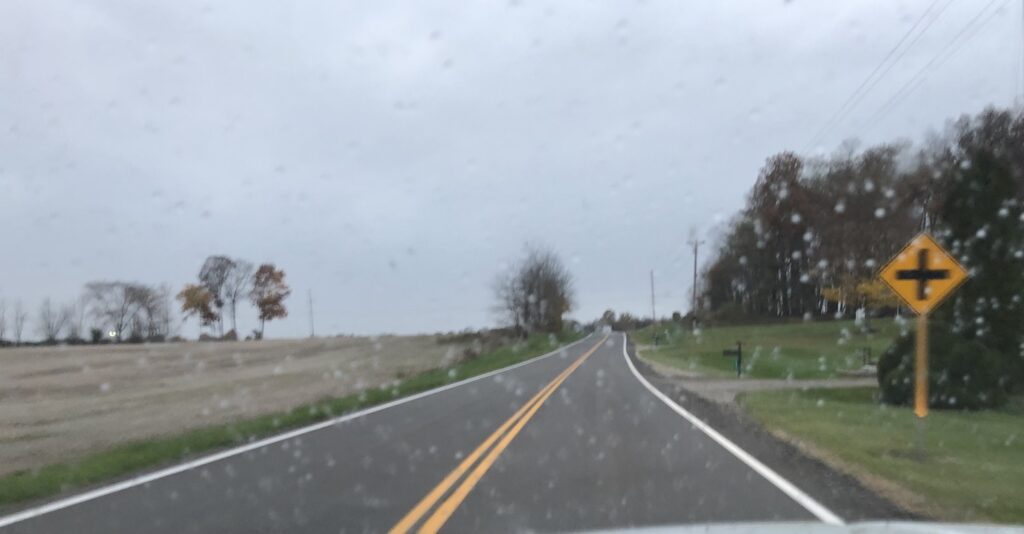
I gave up all hope of doing any more Lincoln Highway this trip and headed home through the deluge.
What have I kept from this adventure? Well, my one souvenir was this mug from Lincoln Motor Court, the purchase of which went toward keeping that charming and cozy relic maintained. No, it was not everything I had hoped; there was too much congestion in the larger towns and the townships close to metropolises like Philadelphia. The joy tended to be strained there. But the memories of roller coastering through the Alleghenies and curving foothills in Ohio, the charming small towns, the roadside relics, will linger forever. The Road is the Way, and I can still feel it.

